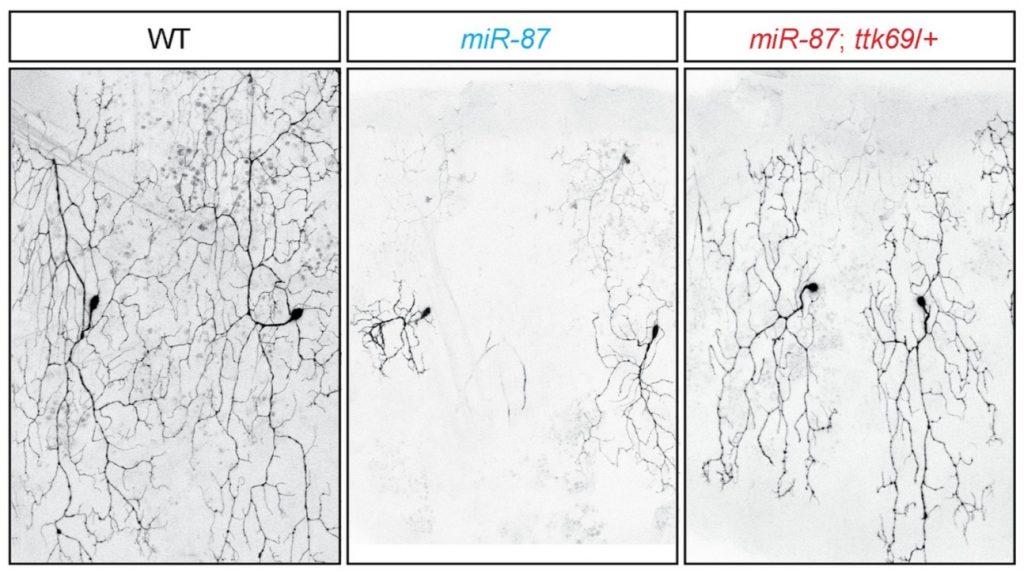Dendrites, the antennae of neurons in the brain and nervous system, process incoming signals through the synaptic terminals that speckle their tree-like arbors. While dendritic structure is largely hard-wired in the adult to maintain the stability of neuronal networks, under certain conditions during development and after disease or injury, neurons have the ability to grow new dendritic branches. The discovery of a molecular program triggering dendrite regrowth would be interesting to medical science as a potential means to stimulate neurons to build new dendrites to replace those lost to injury or illness. In a study recently published in the journal PLOS Genetics, a research team led by Professor Kazuo Emoto at the International Research Center for Neurointelligence (IRCN) and the Graduate School of Science at The University of Tokyo report the discovery of a molecular switch for dendrite regrowth in development and after injury involving a microRNA, miR-87, and a protein, Tramtrack69.
The team used a model system for neural development, the post-larval stage of the laboratory fruit fly Drosophila melanogaster. In the peripheral nervous system, a class of neurons called C4da lose and regrow their dendrites during a critical developmental transition period called metamorphosis. The same neurons can also regrow dendrites lost to injury during the earlier larval stage when they are normally growing out. The researchers used the dendrite regrowth phenomena as an assay to screen for biological factors that may regulate them. They were led to examine a curious class of nucleic acids called microRNAs, short RNA sequences that bind to and regulate mirror sequences on messenger RNAs for various genes, including those regulating neuronal development. When one particular microRNA called miR87 was deleted from the genome, C4da neurons failed to regenerate dendrites. Conversely, when miR87 was overexpressed the neurons grew excess dendrites. How did miR87 help to regrow dendrites?
Using a bit of scientific detective work, clues to the molecular target of miR87 were revealed by matching its genetic sequence against known protein-encoding DNA sequences, resulting in the identification of a candidate polypeptide called TramTrack69 (ttk69), a class of protein called a transcriptional repressor, which turns a group of genes off, typically by occupying a piece of DNA critical for the synthesis of RNA (that, in turn, makes the proteins for cells to function). Genetic experiments proved that ttk69 was a target of miR87: reducing ttk69 RNA levels allowed dendrites to regenerate when miR87 was missing, indicating that ttk69 likely suppresses one or more genes that control dendrite growth. The last piece of the puzzle was showing that this miR87 and ttk69 “control switch” could facilitate dendrite regeneration after injury causing the loss of larval dendrites, indicating the potential of these molecules in the design of future medical applications for dendrite growth after loss due to disease or injury.
Correspondent: Charles Yokoyama, Ph.D., IRCN Science Writing Core
Reference: Kitatani, Y., Tezuka, A., Hasagawa, E., Yanagi, S., Togashi, K., Tsuji, M., Kondo, S., Parrish, J.Z., Emoto, K. (2020) Drosophila miR-87 promotes dendrite regeneration by targeting the transcriptional repressor Tramtrack69. PLOS Genetics, published online: August 7, 2020, DOI: 10.1371/journal.pgen.1008942

Figure: Removing one copy of the Tramtrack69 (ttk69) gene rescues dendrite regeneration defects in miR87 knockout neurons, indicating that miR87 requires ttk69 for its effects.
Media Contact: The author is available for interviews in English.
Professor Kazuo Emoto, Ph.D.
International Research Center for Neurointelligence (IRCN)
The University of Tokyo Institutes for Advanced Study
Mayuki Satake
Public Relations
International Research Center for Neurointelligence (IRCN)
The University of Tokyo Institutes for Advanced Study
pr@ircn.jp


